Archaeology
Ancient Egyptian 'office workers' had terrible posture just like us, disfigured skeletons reveal
Ancient Egyptian scribes worked in cramped and hunched over positions that were so extreme, it may have led to them developing osteoarthritis in their joints and other skeletal issues, a new analysis reveals.
Archaeologists examined the skeletons of 69 adult males — 30 of whom were scribes — who were buried between 2700 and 2180 B.C. in a necropolis in Abusir, a pyramid burial complex in Egypt. A new analysis of their bones was published Thursday (June 27) in the journal Scientific Reports.
Being a scribe in ancient Egypt was considered a high-status career, especially since these men could read and write — a skill held by only 1% to 5% of the ancient Egyptian population, according to the University College London.
"Officials with scribal skills belonged to the elite of the time and formed the bacKBOne of the state administration," study co-author Veronika Dulíková, an Egyptologist at the Czech Institute of Egyptology of the Faculty of Arts at Charles University, in the Czech Republic, told Live Science in an email. "They were therefore important for the functioning and management of the whole country."
But scribes experienced downsides to their jobs, too, since they often performed rePetitive administrative tasks that involved sitting in certain positions for prolonged periods of time, according to a statement.
Researchers noticed that the scribes' skeletons showed more obvious degenerative changes in their joints, compared to the adult males who held other occupations. The areas most affected included the right collarbone, the right upper arm bone where it connects with the shoulder socket, the bottom of the right thigh bone where it meets the knee and the vertebra at the top of the spine.
Related: When did the ancient Egyptians start using hieroglyphs?
-

 Archaeology1m ago
Archaeology1m agoEgypt’s Stυппiпg Archaeological Discovery: Alieп Symbols oп Aпcieпt Coiпs Spark Extraterrestrial Theories
-

 Archaeology1m ago
Archaeology1m ago2,800-year-old burial mound with sacrifices unearthed in Siberia is eerily similar to Scythian graves
-

 Archaeology1m ago
Archaeology1m agoNabta Playa: A mysterious stone circle that may be the world's oldest astronomical observatory
-

 Archaeology1m ago
Archaeology1m agoAncient DNA from South Africa rock shelter reveals the same human population stayed there for 9,000 years
-

 Archaeology1m ago
Archaeology1m ago'Extraordinary' burial of ancient Egyptian governor's daughter discovered in a coffin within another coffin
-

 Archaeology1m ago
Archaeology1m agoGrand tomb of Roman gladiator found in Turkey actually contains the remains of 12 other people
-

 Archaeology1m ago
Archaeology1m agoNeanderthals and modern humans interbred 'at the crossroads of human migrations' in Iran, study finds
-

 Archaeology1m ago
Archaeology1m agoDid Neanderthals wear clothes?



























